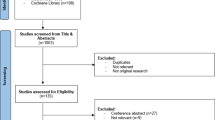Abstract
Straight line scoring (SLS), defined as trainee assessments with the same score for all evaluation items, is statistically improbable and potentially indicates inaccurate assessment. Factors contributing to higher SLS rates are unknown, and knowledge of SLS prevalence within oncologic training is lacking. SLS frequency was measured for evaluations from all Accreditation Council for Graduate Medical Education (ACGME)-accredited programs at a single cancer care institution between 2014 and 2018. SLS prevalence was estimated using hierarchical linear models (HLM) that considered characteristics of evaluator, trainee, and evaluation potentially related to SLS. Results were compared with national SLS rates. Six thousand one hundred sixty evaluations were included from 476 evaluators. Overall prevalence of SLS was 12.1% (95% CI 4.5–28.8). Residents (vs fellows) were less likely to have SLS evaluations (OR 0.5, 95% CI 0.4–0.8), though for all trainees increasing training year corresponded with increasing SLS frequency (OR 1.5, 95% CI 1.3–1.7). SLS was more common in procedural specialties compared with medical specialties (OR 2.1, 95% CI 1.1–3.8). Formative evaluations had lower SLS rates (OR 0.6, 95% CI 0.5–0.9) than summative evaluations, while milestone-based evaluations had higher rates than those that were not milestone-based (OR 1.5, 95% CI 1.03–2.2). Features of evaluators, such as subspecialty within oncology, and of trainees, such as seniority or trainee type, were related to SLS. Summative intent and milestone-based evaluations were more likely to be straight line scored. Specific evaluation scenarios at higher risk of SLS should be further examined.

Similar content being viewed by others
Data Availability
National data used within the current manuscript is publicly available, and institutional data can be made upon specific relevant request.
References
Nasca TJ, Philibert I, Brigham T, Flynn TC (2012) The next GME accreditation system — rationale and benefits. N Engl J Med 366(11):1051–1056
Hauer KE, Vandergrift J, Hess B, Lipner RS, Holmboe ES, Hood S, Iobst W, Hamstra SJ, McDonald FS (2016) Correlations between ratings on the resident annual evaluation summary and the internal medicine milestones and association with ABIM certification examination scores among US internal medicine residents, 2013-2014. JAMA 316(21):2253–2262
Beeson MS, Holmboe ES, Korte RC, Nasca TJ, Brigham T, Russ CM, Whitley CT, Reisdorff EJ (2015) Initial validity analysis of the emergency medicine milestones. Acad Emerg Med 22(7):838–844
Aagaard E, Kane GC, Conforti L, Hood S, Caverzagie KJ, Smith C, Chick DA, Holmboe ES, Iobst WF (2013) Early feedback on the use of the internal medicine reporting milestones in assessment of resident performance. J Grad Med Educ 5(3):433–438
Peabody MR, O’Neill TR, Peterson LE (2016) Examining the functioning and reliability of the family medicine milestones. J Grad Med Educ 9(1):46–53
Turner TL, Bhavaraju VL, Luciw-Dubas UA, Hicks PJ, Multerer S, Osta A, McDonnell J, Poynter S, Schumacher DJ, Tenney-Soeiro R, Waggoner-Fountain L, Schwartz A, the Association of Pediatric Program Directors Longitudinal Educational Assessment Research Network–National Board of Medical Examiners Pediatrics Milestones Assessment Group (2017) Validity evidence from ratings of pediatric interns and subinterns on a subset of pediatric milestones. Acad Med 92(6):809–819
Heath JK, Dine CJ (2019) ACGME milestones within subspecialty training programs: one institution’s experience. J Grad Med Educ 11(1):53–59
Beeson MS, Hamstra SJ, Barton MA, Yamazaki K, Counselman FL, Shayne PH, Holmboe ES, Muelleman RL, Reisdorff EJ (2017) Straight line scoring by clinical competency committees using emergency medicine milestones. J Grad Med Educ 9(6):716–720
Hamstra SJ, Edgar L, Sangha S (2018) Milestones National Report 2018, Milestones Resources National Report. [Online]. Available: https://www.acgme.org/What-We-Do/Accreditation/Milestones/Resources. Accessed 22 Oct 2018
Chemtob CM, Tanaka P, Keil M, Macario A (2018) Analysis of milestone-based end-of-rotation evaluations for ten residents completing a three-year anesthesiology residency. Cureus 10(8):e3200
Sebesta EM, Cooper KL, Badalato GM (2019) Program director perceptions of usefulness of the accreditation Council for Graduate Medical Education Milestones System for urology resident evaluation. Urology 124:28–32
Drolet BC, Marwaha JS, Wasey A, Pallant A (2017) Program director perceptions of the general surgery milestones project. J Surg Educ 74(5):769–772
Hariton E, Bortoletto P, Barnes KL, Kaimal AJ, Stagg AR (2018) Resident and program director’s perceptions of milestone-based feedback in obstetrics and gynecology. J Med Educ Curric Dev 5:238212051877479
Conforti LN, Yaghmour NA, Hamstra SJ, Holmboe ES, Kennedy B, Liu JJ, Waldo H, Selden NR (2018) The effect and use of milestones in the assessment of neurological surgery residents and residency programs. J Surg Educ 75(1):147–155
Carter WA (2014) Milestone myths and misperceptions. J Grad Med Educ 6(1):18–20
Author information
Authors and Affiliations
Corresponding author
Ethics declarations
Conflict of Interest
The authors declare that they have no conflict of interests.
Ethics Approval
This research received appropriate Institutional Review Board (IRB) approval.
Additional information
Publisher’s Note
Springer Nature remains neutral with regard to jurisdictional claims in published maps and institutional affiliations.
This research was presented as an oral presentation at the Texas Educator’s Academies Collaborative for Health Professionals Southeast Educational Symposium (TEACH-S) in May 2019.
Appendix
Appendix
Rights and permissions
About this article
Cite this article
Hinchcliff, E., Gunther, J., Ponnie, A.E. et al. A Not So Perfect Score: Factors Associated with the Rate of Straight Line Scoring in Oncology Training Programs. J Canc Educ 37, 615–620 (2022). https://doi.org/10.1007/s13187-020-01855-6
Published:
Issue Date:
DOI: https://doi.org/10.1007/s13187-020-01855-6




